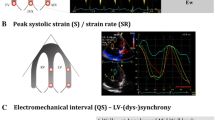Abstract
The force–frequency relationship (FFR) reflects alterations in intracellular calcium cycling during changing heart rate (HR). Tachycardia-induced heart failure is associated with depletion of intracellular calcium. We hypothesized (1) that the relative resistance to tachycardia-induced heart failure seen in neonatal pigs is related to differences in calcium cycling, resulting in different FFR responses and (2) that pretreatment with digoxin to increase intracellular calcium would modifies these changes. LV +dP/dt was measured during incremental right atrial pacing in 16 neonatal and 14 adult pigs. FFR was measured as the change in +dP/dt as HR was increased. Animals were randomized to control or intravenous bolus digoxin (n = 8 neonate pigs in the 0.05 mg/kg group and n = 7 adult pigs in the 0.025 mg/kg group) and paced for 90 min at 25 bpm greater than the rate of peak +dP/dt. Repeat FFR was then obtained. The postpacing FFR in neonatal control pigs shifted rightward, with peak force occurring 30 bpm greater than baseline (P < 0.03). There was no vertical shift; thus, force at 150 bpm decreased (P < 0.03) and force at 300 beats/min increased (P < 0.08). In adult control pigs, FFR shifted downward (P < 0.01), with decreased force generation at all HRs. In both neonates and adult pigs, digoxin increased +dP/dt at all HRs; however, in neonate pigs digoxin decreased the contractile reserve by abrogation of the rightward shift of FFR. An adaptive response to tachycardia in the neonate pig leads to improved force generation at greater HRs. Conversely, the response of the mature pig heart is maladaptive with decreased force generation. Pretreatment with digoxin modifies these responses.





Similar content being viewed by others
References
Anderson P, Manring AA, Johnson EA (1973) Force-frequency relationship. A basis for a new index of cardiac contractility? Circ Res 33:665–671
Anderson PA, Rankin JS, Arentzen CE, Anderson RW, Johnson EA (1976) Evaluation of the force-frequency relationship as a descriptor of the inotropic state of canine left ventricular myocardium. Circ Res 39:832–839
Cheung MM, Smallhorn JF, McCrindle BW, Van Arsdell GS, Redington AN (2005) Non-invasive assessment of ventricular force-frequency relations in the univentricular circulation by tissue Doppler echocardiography: a novel method of assessing myocardial performance in congenital heart disease. Heart 91:1338–1342
Cheung MM, Smallhorn JF, Vogel M, Van AG, Redington AN (2006) Disruption of the ventricular myocardial force-frequency relationship after cardiac surgery in children: noninvasive assessment by means of tissue Doppler imaging. J Thorac Cardiovasc Surg 131:625–631
Crozatier B (1998) Force-frequency relations in nonfailing and failing animal myocardium. Basic Res Cardiol 93(Suppl 1):46–50
Faggiano P, Colucci WS (1996) The force-frequency relation in normal and failing heart. Cardiologia 41:1155–1164
Hasenfuss G, Holubarsch C, Hermann HP, Astheimer K, Pieske B, Just H (1994) Influence of the force-frequency relationship on haemodynamics and left ventricular function in patients with non-failing hearts and in patients with dilated cardiomyopathy. Eur Heart J 15:164–170
Higginbotham MB, Morris KG, Williams RS, McHale PA, Coleman RE, Cobb FR (1986) Regulation of stroke volume during submaximal and maximal upright exercise in normal man. Circ Res 58:281–291
Inagaki M, Yokota M, Izawa H, Ishiki R, Nagata K, Iwase M et al (1999) Impaired force-frequency relations in patients with hypertensive left ventricular hypertrophy. A possible physiological marker of the transition from physiological to pathological hypertrophy. Circulation 99:1822–1830
Kushnir A, Shan J, Betzenhauser MJ, Reiken S, Marks AR (2010) Role of CaMKIIdelta phosphorylation of the cardiac ryanodine receptor in the force frequency relationship and heart failure. Proc Natl Acad Sci USA 107:10274–10279
Lemaire S, Piot C, Leclercq F, Leuranguer V, Nargeot J, Richard S (1998) Heart rate as a determinant of L-type Ca2+ channel activity: mechanisms and implication in force-frequency relation. Basic Res Cardiol 93(Suppl 1):51–59
Mulieri LA, Hasenfuss G, Leavitt B, Allen PD, Alpert NR (1992) Altered myocardial force-frequency relation in human heart failure. Circulation 85:1743–1750
Pieske B, Kretschmann B, Meyer M, Holubarsch C, Weirich J, Posival H et al (1995) Alterations in intracellular calcium handling associated with the inverse force-frequency relation in human dilated cardiomyopathy. Circulation 92:1169–1178
Piot C, Lemaire S, Albat B, Seguin J, Nargeot J, Richard S (1996) TI-high frequency-induced upregulation of human cardiac calcium currents. Circulation 93:120–128
Schmidt MR, Kristiansen SB, White P, Smerup M, Botker HE, Vogel M et al (2004) Glucose-insulin infusion improves cardiac function during fetal tachycardia. J Am Coll Cardiol 43:445–452
Sossalla S, Fluschnik N, Schotola H, Ort KR, Neef S, Schulte T et al (2010) Inhibition of elevated Ca2+/calmodulin-dependent protein kinase II improves contractility in human failing myocardium. Circ Res 107:1150–1161
Vornanen M (1992) Force-frequency relationship, contraction duration and recirculating fraction of calcium in postnatally developing rat heart ventricles: correlation with heart rate. Acta Physiol Scand 145:311–321
Wiegerinck RF, Cojoc A, Zeidenweber CM, Ding G, Shen M, Joyner RW et al (2009) Force frequency relationship of the human ventricle increases during early postnatal development. Pediatr Res 65:414–419
Wier WG, Yue DT (1986) TI-intracellular calcium transients underlying the short-term force-interval relationship in ferret ventricular myocardium. J Physiol 376:507–530
Acknowledgments
This project was financially supported by Fondation Leducq and The Danish Heart Foundation.
Author information
Authors and Affiliations
Corresponding author
Rights and permissions
About this article
Cite this article
Schmidt, M.R., White, P.A., Khambadkone, S. et al. The Neonatal But Not the Mature Heart Adapts to Acute Tachycardia by Beneficial Modification of the Force–Frequency Relationship. Pediatr Cardiol 32, 562–567 (2011). https://doi.org/10.1007/s00246-011-9899-6
Received:
Accepted:
Published:
Issue Date:
DOI: https://doi.org/10.1007/s00246-011-9899-6




